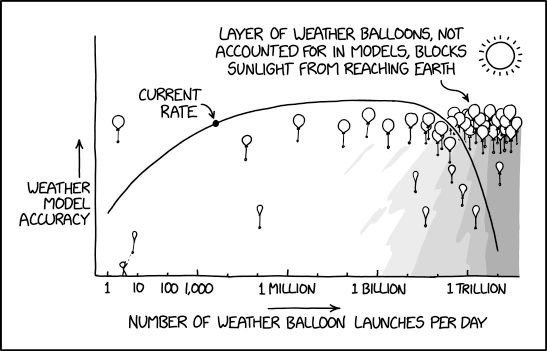Weather Balloons

Once you add the balloons into the model, it makes forecasting easier overall--the forecast is always 'cold and dark, with minimal solar-driven convection.'

Once you add the balloons into the model, it makes forecasting easier overall--the forecast is always 'cold and dark, with minimal solar-driven convection.'
A weather balloon is a balloon that carries meteorological instruments into the high atmosphere and sends readings back to scientists, who use the information to make weather and climate predictions. Typically it will rise up until the difference between the pressure inside the balloon and that outside gets too great, and the membrane breaks and the fragments of balloon fall back down. This is why the graph plots the number of balloons launched each day, rather than overall, since most balloons launched on one day would be gone from the sky the next day.
The chart in the comic claims that weather forecasting accuracy correlates with the number of weather balloons launched each day, with accuracy increasing fast at first, followed by diminishing returns as the number of launches increases. However, it forecasts that if the rate of balloon launches is sufficiently high, it could provide so many balloons that they actually impact the weather by blocking out sunlight. If the balloons are not included in the weather model, the accuracy of the model based on the readings provided by the many balloons decreases. This starts to happen somewhere between 100 billion to 1 trillion weather balloons launched each day. The accuracy of the model drops completely towards zero for around 10 trillion launched each day, where it even falls below the accuracy for just a single balloon (which may or may not be augmented by non-balloon information) at the start of the graph.
While the number of weather balloon launches impacts weather model accuracy, it's not the only factor. Ground stations have been collecting and collating useful surface data for centuries. Scientific understanding of the physical processes in the atmosphere has also improved, only in part due to balloons, and the speed of computers used in analyses and simulations has increased by many orders of magnitude. The existence of weather and geophysical satellites also significantly improves forecasts, as they can continuously gain information about clouds and temperatures over huge areas, while weather balloons capture information as they rise through only a single air-column for a limited duration.
The surface area of the Earth is around 510 short-scale trillion square meters (5.1×1013 m2), and a typical weather balloon (while smaller at launch) will expand to approximately 6 m diameter at altitude; this covers an area slightly under 30 m2, within a just marginally larger 'air surface area' at height. This makes it entirely possible to blanket the whole Earth with around 18 trillion standard weather balloons - or possibly even fewer, given the current availability of larger balloon models each more than twice the width, or four times the area. This isn't far off the implications given by the graph. On the other hand, the inherent translucency of the balloon material, the tendency of the balloons to jostle vertically (the illustration implying that it's not just a single layer of close-packed balloons), and the need to synchronize launches and ascents to try to form an optimal single layer, might make complete coverage difficult to accomplish without a slightly greater number of launches. Alternatively, roughly doubling this coverage could be achieved by launching when the balloons will end up in the sunlit hemisphere at any given time.
The joke in the title text is that when there are so many balloons that sunlight is entirely blocked, weather will always be the same - dark and cold - so we won't need complex models to forecast it. Also, when there is no heating of the Earth's surface, the solar-driven convection that drives storms and weather patterns would stop. Of course, plants and algae would start to die out, followed shortly by humans and most other life on Earth. However, assuming that the balloons are being launched by humans, the number of them that it would be possible to launch would fall as the population and social structures began to collapse, mitigating the impact on the weather. The pollution from the trillions of balloons would last for longer, but wouldn't prevent sunlight from reaching the Earth's surface.